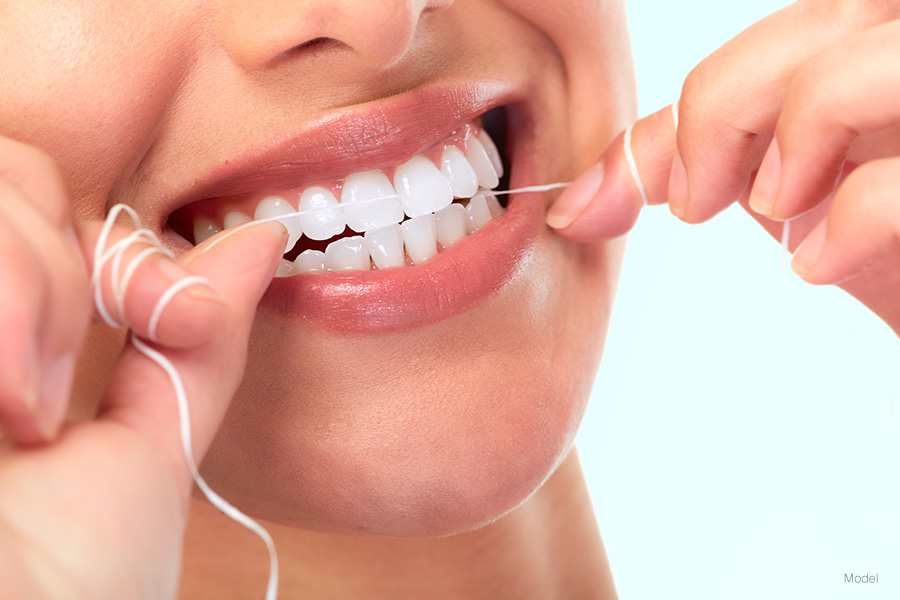7 Oral Hygiene Tips to Prevent Gum Disease and Tooth Loss
5-Minute Read:
You may think that you have dental hygiene down to a science. You brush twice daily, floss daily, and are careful about the foods and beverages you consume. However, you may not be making the most of your dental routine.
Dr. Afshin Salamati understands that caring for your teeth is of vital importance. Not only does proper oral hygiene keep your smile looking bright, but it also helps keep you healthy.

Below, he offers seven tips for better dental habits.
1. Proper Brushing Techniques to Use Twice a Day
First, make sure you have a quality toothbrush. Use a brush with multi-level bristles, as these can get between teeth and other hard-to-reach places. Make sure your toothbrush has soft bristles and is the right size for your mouth. Most importantly, replace your toothbrush every two to three months, as a worn-out toothbrush doesn’t work as well and can harbor bacteria.
When brushing, use gentle, circular motions. Scrubbing your teeth back and forth doesn’t do a good job of cleaning your teeth. You should hold the toothbrush at a 45-degree angle, allowing you to brush where the teeth and gums meet. There are several different brushing techniques, so try them out and see which works best for you.
2. Proper Flossing Techniques to Use Once a Day
Most people don’t floss as much as they should, and some ignore it altogether. However, it’s vital to keep the spaces between your teeth as clean as the surfaces, using classic string floss or pre-threaded flossers — whichever you’re most comfortable with.
Start by guiding the floss between your teeth, moving towards the gum line. Once you reach the gum line, carefully slide the floss into the space between your tooth and gums. Next, rub the floss up and down, following the tooth’s shape. Repeat this on both sides of every tooth, including on the backs of your molars.
If you find flossing annoying or difficult, consider trying interproximal brushes. Interproximal brushes are designed to get into the spaces between your teeth that toothbrushes miss — much like floss. They look like tiny bottle brushes and come in a variety of sizes. Interproximal brushes help remove food, plaque, and other bacteria that contribute to tooth decay between your teeth.
3. How Fluoride Protects Teeth
Fluoride is a naturally occurring mineral found in soil and water that has been proven to prevent cavities and tooth decay. It works by strengthening the tooth’s enamel, making it harder for bacteria to break down your teeth.
Fluoride is added to city water supplies and oral care products like toothpaste and mouthwash. Many dentists offer fluoride rinses or apply fluoride directly onto the tooth in gel form.
4. Advantages of Using an Electric Toothbrush
While electric toothbrushes seem more prevalent than ever, a 2022 report found that only 41% of people surveyed have used an electric toothbrush, while 58% still use manual brushes.
Electric toothbrushes offer a variety of benefits over manual toothbrushes, including:
- Getting rid of more plaque
- Smaller brush heads make cleaning hard-to-reach places easier
- More thorough cleaning
- Less abrasive
- Extra features like timers and interchangeable brush heads
- Easier for children and patients with arthritis to better clean their teeth
When choosing an electric toothbrush, select one with the ADA Seal of Approval. The ADA applies rigorous quality standards to products that toothbrush manufacturers must meet in order to receive ADA approval.
5. Importance of Drinking Water After Consuming Sticky or Sugary Foods and Beverages
Everyone knows that drinking water has a myriad of benefits. But did you know it also helps you keep your teeth clean and healthy?
Coffee, sports drinks, juices, and sodas are acidic and often sugary, while dark beverages like colas, tea, coffee, and wine stain your teeth.
Drinking water not only does a better job of keeping you hydrated than any other beverage but also removes food particles and sugary or sticky residue to help prevent tooth decay. Water helps neutralize the pH of your mouth, washing away the excess acids produced when eating, and protecting your enamel from deterioration.
6. Recognizing Symptoms of Early Gum Disease and Possible Tooth Decay
Most people notice signs of periodontal disease (gum disease) or tooth decay because they have a toothache or notice their gums are tender and swollen. However, some people may have gum disease and see no signs at all.
Symptoms of gum disease include:
- Bleeding gums while brushing or flossing
- Puffy, red gums
- Receding gums, or pockets between your tooth and gums
- Changes in your bite, or feeling that your teeth are loose or moving
If you notice any of the above signs, schedule an appointment with your dentist or periodontist to avoid the progression of gum disease.
7. Importance of Regular Dental Visits
It may seem like seeing a dentist twice yearly is a hassle just to get your teeth cleaned. However, it’s essential that you visit your dentist regularly to ensure your mouth and teeth are healthy. Dentists provide preventative care like thorough cleanings, fluoride treatments, and exams to help you avoid dental issues in the future. They screen for oral cancer and can direct you to the proper specialist if you require further dental interventions.
Learn More About Periodontics and Dental Implants in Beverly Hills
If you’re looking for a top-quality periodontist or need dental implants in Beverly Hills, Dr. Salamati has you covered. With nearly 25 years of experience caring for patients with gum disease and its associated issues, Dr. Salamati has the knowledge and skills to restore your smile to its former glory.
For more information on Dr. Salamati and the services he offers, call for a consultation at 310-275-1090 or fill out the online contact form.
